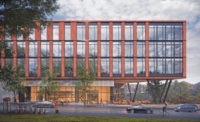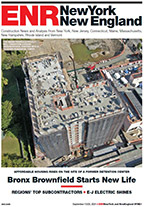Other sectors contributing to the region's strength were public works from agencies such as the Metropolitan Transit Authority and the Dormitory Authority of the State of New York. Relief work related to Hurricane Sandy has also bolstered the region, but it is "not as big as you would think," Anderson contends. "In any single year, it is not more than $1 billion or $2 billion," but there is always ongoing capital expansion, he says, noting that New York City's capital budget is about $10 billion and the MTA's is about $5 billion.
The outlook in New Jersey is also strong. The private sector and public agencies in the Garden State expect construction spending for 2015-2016 at a new high of $39.8 billion, according to an analysis by the New Jersey Alliance for Action, a construction industry advocacy group.
However, that forecast is vulnerable to funding decisions by Gov. Chris Christie (R) and the state legislature, according to Philip Beachem, president of the alliance. In particular, he cited funding for the State Transportation Trust Fund that has yet to be renewed.
Marcos Diaz Gonzalez, senior vice president and New York metro executive for AECOM, sees strong demand in the water, transportation and facilities markets on the design side. On the construction side, "Our commercial and sports sectors have been particularly strong," he says.
AECOM was the architect of record and the construction manager for the Barclays Center, the sports and entertainment complex in downtown Brooklyn. It also is working on the National Tennis Center stadium roof upgrade in Flushing, Queens.
Regionally, Diaz Gonzalez expects growth in the private commercial buildings market and the public facilities sector as well as in the infrastructure markets where resiliency plays a role.
"The current investment trends go above and beyond infrastructure hardening and climate adaptation and into the realm of asset management, cybersecurity, economic resiliency and integrated, resilient city-making," he said.
Staying Sustainable
Peter Glus, ARCADIS director of business development for New York City, also sees that shift as a major trend in the region and the city.
Although there is a lot of talk about the need to replace or refurbish the nation's aging infrastructure, a lot of the post-Sandy funding does not address longer-term sustainability issues, Glus says.
Momentum is still increasing from Sandy funding, but he sees it peaking in 2015 and then stabilizing.
When that funding reaches the end of its cycle, Glus sees the momentum being carried by sustainability projects such as Mayor Bill de Blasio's One City: Built to Last program for New York City.






